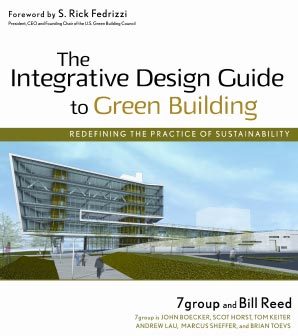September 18, 2009 Categories: Reviews
The Integrative Design Guide to Green Building: Redefining the Practice of Sustainability
2009. John Wiley & Sons. 398 pp. $75.
Do not be deceived by this book’s new-agey start. On the first page of the introduction, we read, “To achieve the health of the Whole, we must ask ourselves how the process of building can be a catalyst for a discovery process that addresses the interrelationships of all living and technical systems in the service of sustaining the health of all life.” {xiii} The authors are in fact well-grounded in reality, and by page 19 they hit their stride with a detailed explanation of how paint color in a schoolroom affects the planet.

Basically, more reflective surfaces allow lighting designers to use fewer bulbs. Fewer bulbs mean less heat output and lower cooling costs, and less energy used altogether. Unfortunately, in normal construction lighting designers don’t design to the paint color because they don’t know it — they use averages based on past experience in similar buildings. Similarly, HVAC engineers don’t find out the actual heating and cooling requirements for the rooms, they “typically . . . take the LPD values out of ASHRAE tables for the associated building type, . . . or they base these values on assumptions from past experience.” {22}
Designing unique buildings using generic numbers and ending with twice as many light fixtures as necessary might not be a big deal if we had unlimited free energy. But until that day, we need to find ways for the various experts involved to work together to design for the actual building they’re working on. No meditations on the capitalized Whole are required; it’s just the only way to get the job done.
In normal construction, as the authors tell it, what usually happens is that at some point the project is discovered to be over budget, and “value engineering” ensues. This process is accurately skewered by the joke they repeat: it neither adds value nor involves engineering. Instead, extras like roof gardens and other green add-ons are pruned in order to reduce the first cost of the building. {10}
You could say that the whole purpose of integrative design is to do real value engineering much earlier in the project, saving both first cost and operating cost by making sure all the systems work together. And there’s just no way for the systems to work together unless the HVAC engineers are talking — early, seriously, and often — to the lighting designers and the architects and the owners. And it would be good to have the builders involved as well.
More meetings with more people? Yes. More useful meetings? Yes, if the design process itself is properly redesigned. More give-and-take with professionals in other disciplines who don’t share your exact viewpoint? Yes. Close interaction? Yes. In plain words: “If team members are not engaged in solidified relationships with each other, then the technical systems and building components they are designing likely will not be either.” {198}
Another way of putting the authors’ point is that green is not a line item, or a product, or even a service that you can buy off the shelf. Sometimes part of green may be one of these things, but primarily it’s how everything fits together. The authors’ experience has taught them that rule-of-thumb green can be wrong, that sometimes (for example) low-flow appliances do not relate best to the building’s surroundings, and sometimes it is good for the habitat to build on a sand dune. {250, 273}
The book’s first four chapters lay the foundation. The next four take you through the integrative building process, in which cross-disciplinary issues are addressed first at very general levels and then with increasing specificity as the work proceeds. At every turn of the road, it’s easy for participants to fall back into their old ways, designing on standard assumptions in their own silos, and not meaningfully checking in and working with other specialists. The book’s discussion is divided between the minutiae of design and construction, and ways to keep the interactive integrative process on track.
Their vision extends beyond the building, and beyond the construction into operations. Their common-sense suggestions — name each individual piece of equipment so that each one can be distinguished easily by the people operating them, and seek out post-occupancy evaluations — are much more likely to happen if they are carried out within an integrative framework that already values and encourages constant careful communication.
S. Rick Fedrizzi — president, CEO, and founding chair of the US Green Building Council — has written a nice foreword. Fortunately, that hasn’t inhibited or muzzled the authors, who explain the ways in which LEED can be misused, and how focusing too single-mindedly on achieving LEED points can actually diminish a building’s quality. It’s good to have a green ruler, but a ruler is not a plan.
The authors appear to specialize in large projects. It’s not entirely clear how an integrative process would work in a two-story infill mixed-use building, but it could hardly be more difficult than a major library or office building. Read this book for the great stories; buy and save it for the sage advice on how to make more good stories happen.
#
